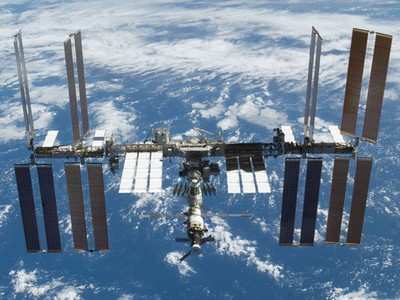Sun, Apr 15, 2012
No Government Funding Will Be Used For Its Operation
Researchers will be able to expose experiments to the weightlessness and vacuum of space by using a new commercial platform outside of International Space Station (ISS). NanoRacks, a private company already operating research facilities under a NASA Space Act Agreement for use of the station's U.S. National Laboratory, will develop and operate the External Platform Program (EPP) to take advantage of the only orbiting lab that offers long-term, repeat access to the unique environment of unpressurized space.

The EPP and equipment will be developed and operated using only commercial funding. NASA will contribute space station hardware and resources such as power and data transmission systems. The Center for the Advancement of Science in Space (CASIS), which manages the portion of the station operated as a U.S. National Laboratory, will reserve the first external platform site for commercial researchers. The external platform, scheduled to be launched by 2014, will provide low-cost access to space. It is designed to encourage users to test materials, biological samples, sensors and sophisticated electronics outside the space station, which orbits 240 miles above Earth.
"This program opens the door to allow commercial users to fully utilize not only the U.S. National Laboratory in a pressurized environment but also outside," said ISS National Laboratory Manager Marybeth Edeen. "It's another example how companies are investing their own money to take advantage of this unique national resource."
NanoRacks selected Astrium North America as a team member in the development of the EPP facility. The program capitalizes on the history and strengths of the two companies in providing external payload platforms, operating commercial facilities, and using off-the-shelf hardware, standard interfaces and existing space station data and power systems.
The contributions by NanoRacks and Astrium are the most recent example of NASA efforts to expand the station's research capacity through innovative partnerships with commercial companies. "This new capability offers unique opportunities for the research community and industry to engage in exciting areas of study, including materials and observational sciences," said CASIS Interim Executive Director Jim Royston.
NanoRacks operates platforms inside the U.S. National Laboratory, which also were financed and developed solely by the commercial company and its partners.
More News
A Puff Of Smoke Came Out From The Top Of The Engine Cowling Followed By A Total Loss Of Engine Power On May 9, 2025, about 1020 mountain daylight time, an experimental amateur-buil>[...]
From 2022 (YouTube Edition): Jenny, I’ve Got Your Number... Among the magnificent antique aircraft on display at EAA’s AirVenture 2022 was a 1918 Curtiss Jenny painstak>[...]
Very High Frequency (VHF) The frequency band between 30 and 300 MHz. Portions of this band, 108 to 118 MHz, are used for certain NAVAIDs; 118 to 136 MHz are used for civil air/grou>[...]
“From approximately November 2021 through January 2022, Britton-Harr, acting on behalf of AeroVanti, entered into lease-purchase agreements for five Piaggio-manufactured airc>[...]
Microburst A small downburst with outbursts of damaging winds extending 2.5 miles or less. In spite of its small horizontal scale, an intense microburst could induce wind speeds as>[...]
 NTSB Prelim: Lee Aviation LLC JA30 SuperStol
NTSB Prelim: Lee Aviation LLC JA30 SuperStol Classic Aero-TV: Curtiss Jenny Build Wows AirVenture Crowds
Classic Aero-TV: Curtiss Jenny Build Wows AirVenture Crowds ANN's Daily Aero-Term (05.30.25): Very High Frequency (VHF)
ANN's Daily Aero-Term (05.30.25): Very High Frequency (VHF) Aero-News: Quote of the Day (05.30.25)
Aero-News: Quote of the Day (05.30.25) ANN's Daily Aero-Term (05.31.25): Microburst
ANN's Daily Aero-Term (05.31.25): Microburst



